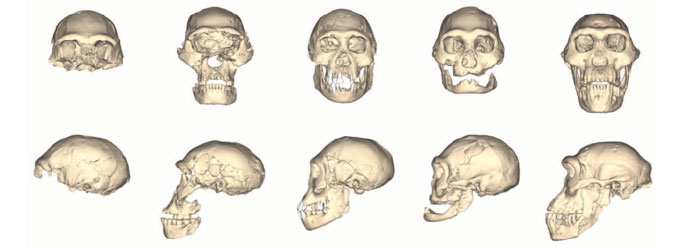by Brian Thomas, M.S., & Frank Sherwin, M.A. *
An international team of scientists made a stunning and controversial discovery from an archaeological site in Dmanisi, a small town in the country of Georgia, that is forcing some scientists to unlearn everything they knew about the story of human evolution. The results from the find appeared in an October issue of the journal Science.1
Among other human skeleton bones, the researchers found five skulls or partial skulls. Some of them looked human, though they were smaller than today's average skull size. But the biggest surprise was that, though these human skulls all had very different shapes, they were buried together within a short time.
Yale University anthropologist Andrew Hill, who was not involved in the discovery, told the Wall Street Journal, "'It gives you a chance to look at variation for the first time.'"2 Instead of showing different transitional human forms living at different times and leading up to modern humans, the fossilized remains at this site showed variation occurring at the same time. Assuming the remains were all human, as the Science authors did, these results end up "drastically simplifying the story of human evolution," according to the WSJ.2
That means, among other things, Homo erectus can no longer be considered an ancestor who lived long before and gave rise to "early Homo" peoples, since the new evidence showed H. erectus, H. rudolfensis, and H. habilis clumped together. "Analysis of the skull and other remains at Dmanisi suggests that scientists have been too ready to name separate species of human ancestors in Africa. Many of those species may now have to be wiped from the textbooks," according to The Guardian.3
Among those species would be Neandertal and Cro-Magnon, which deserve no recognition as separate forms that supposedly evolved into Homo sapiens—modern humans.4 They were uniquely formed people living at the same time as modern-looking people. Australopithecus is also out of the evolutionary line up, now that evolutionists have finally followed its fossil evidence to where creation scientists did long ago when they concluded that it was just an extinct ape and had clearly never evolved into humans.5 Without these key players, the popular pageant of human evolution truly should all be wiped from the textbooks.
If the Dmanisi fossils represent ancient humans, then they show that generations of experts in human evolution have spent effort, time, and research dollars arranging fossil fragments of human skulls into an evolutionary line of descent that never really existed. Perhaps it is time to rethink the whole story.
References
- Lordkipanidze, D. et al. 2013. A Complete Skull from Dmanisi, Georgia, and the Evolutionary Biology of Early Homo. Science. 342 (6156): 326-331.
- Hotz, R. L. Skull Suggests Single Human Species Emerged From Africa, Not Several. The Wall Street Journal. Posted on wsj.com October 17, 2013, accessed October 29, 2013.
- Sample, I. Skull of Homo erectus throws story of human evolution into disarray. The Guardian. Posted on theguardian.com October 17, 2013, accessed October 23, 2013.
- Thomas, B. Neandertals Mixed with Humans in China. Creation Science Update. Posted on icr.org November 3, 2010, accessed November 4, 2013.
- Gish, D. 1975. Man...Apes...Australopithecines...Each Uniquely Different. Acts & Facts. 4 (9).
Image credit: Copyright © 2013 AAAS. Adapted for use in accordance with federal copyright (fair use doctrine) law. Usage by ICR does not imply endorsement of copyright holders.
* Mr. Thomas is Science Writer and Mr. Sherwin is Research Associate, Senior Lecturer, and Science Writer at the Institute for Creation Research.
Article posted on November 8, 2013.




















